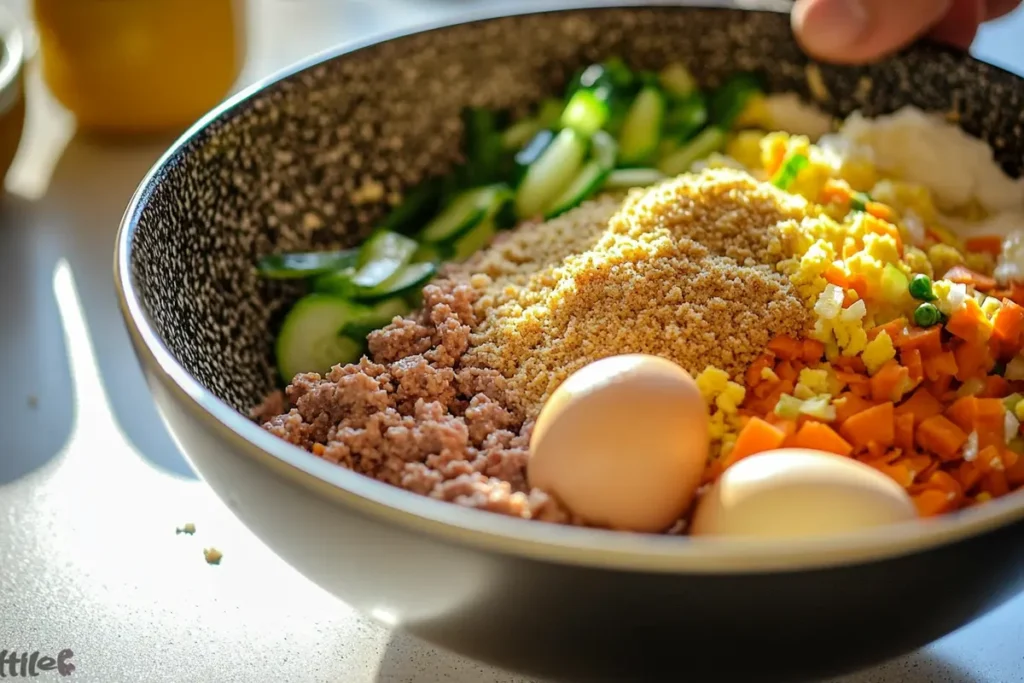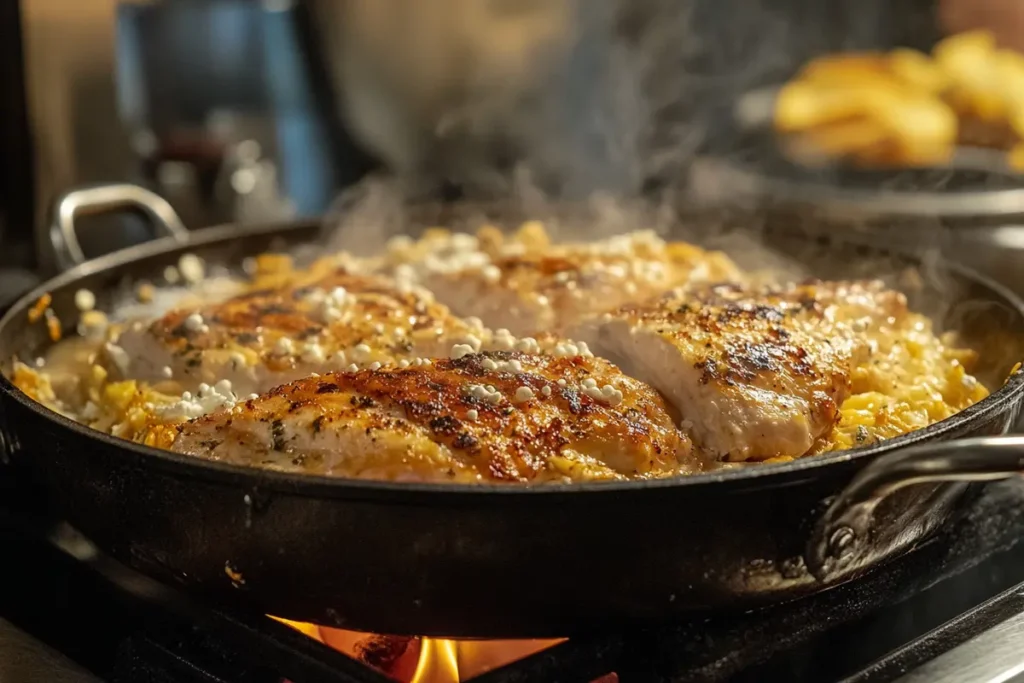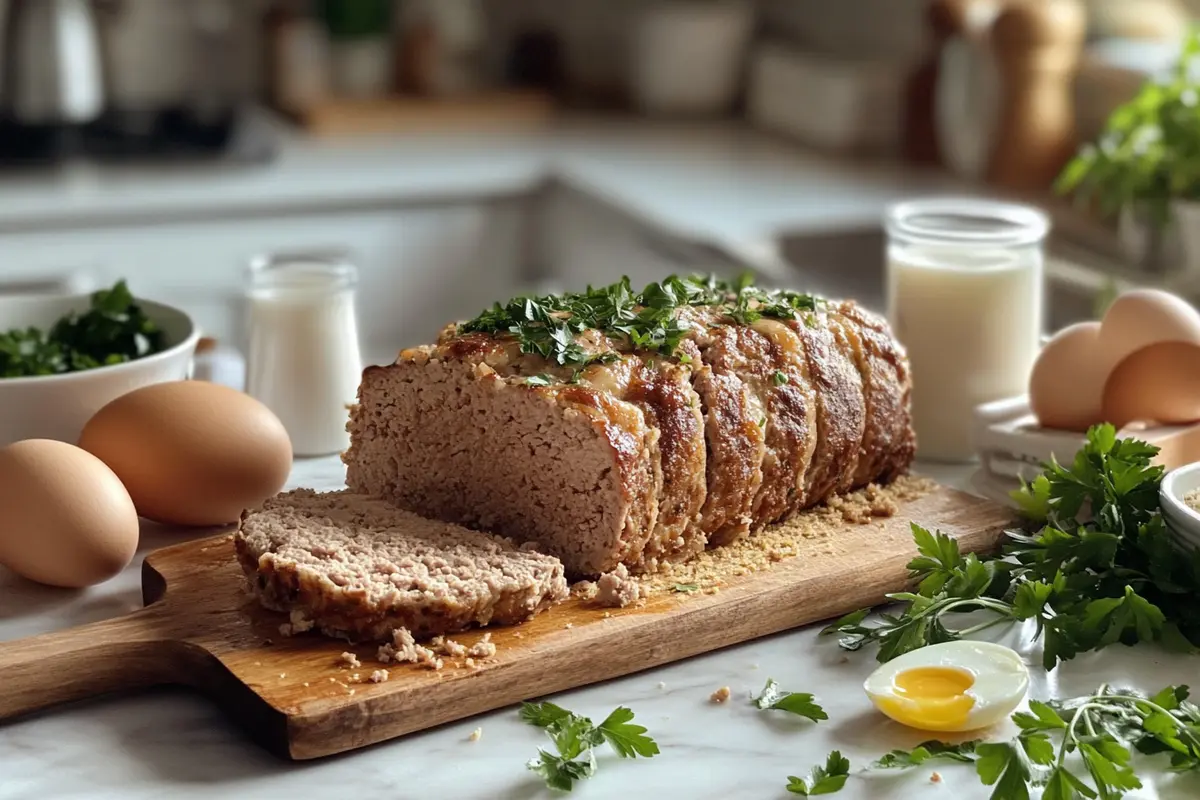What Ingredient Keeps Meatloaf from Falling Apart?
Meatloaf is a classic comfort food loved for its savory, satisfying taste. But let’s face it—nothing is more disappointing than pulling a meatloaf out of the oven, only to have it crumble at the first slice. However, the secret to a perfectly firm yet tender meatloaf lies in using the right binding ingredients and following precise techniques. This article explores what ingredient keeps meatloaf from falling apart and dives into other key factors that influence its structure and texture. From eggs and breadcrumbs to alternative fillers, we’ve got you covered. Let’s dive in!
Understanding the Problem: Why Does Meatloaf Fall Apart?
When your meatloaf crumbles, it’s not just a random mishap; rather, it’s often the result of missing ingredients or small mistakes in preparation. Thankfully, by identifying the root causes, you can avoid these common pitfalls and enjoy a sturdy, delicious loaf every time. So, let’s dig into the key reasons behind this problem and how to address them effectively.
Common Issues with Meatloaf Texture
One of the biggest culprits behind a crumbling meatloaf is a lack of proper binding agents. In fact, without enough eggs, breadcrumbs, or dairy, the ingredients won’t hold together as they should. These binders essentially act like glue, ensuring the meat mixture stays intact. Therefore, if you skip or skimp on these essentials, your loaf is bound to fall apart.
Moreover, overcooking can make matters worse. When the meatloaf becomes too dry, it loses moisture, becoming brittle and fragile. As a result, it’s more likely to crumble when sliced. To prevent this, ensure you’re using the right ratio of wet and dry ingredients, such as eggs and milk, and always monitor your cooking time closely to avoid overbaking.
By addressing these common issues and focusing on proper preparation, you’ll have a better chance of creating a firm, sliceable meatloaf every time. Next, let’s explore the specific ingredients that play a crucial role in solving this common dilemma!
Overmixing and Its Impact on Meatloaf Structure
While under-mixing can leave the loaf uneven, on the other hand, overmixing can turn it tough and rubbery. When you handle the meat mixture too much, you end up breaking down its fibers, which can weaken the final structure. Thus, a gentle touch and a good balance of ingredients are key.
What Ingredient Keeps Meatloaf from Falling Apart? Expert Tips
To wrap up this guide, let’s explore expert tips and practical advice to create a perfect meatloaf. Then, we’ll summarize the key takeaways for your convenience.
Key Ingredients That Keep Meatloaf Together

A Close-Up of Combining Meatloaf Ingredients to Achieve the Perfect Consistency
The right ingredients are the foundation of a perfect meatloaf. If you’re wondering, therefore, what ingredient keeps meatloaf from falling apart, it’s all about the binders and fillers. In fact, they do the heavy lifting in holding everything together.
The Essential Role of Eggs in Binding Meatloaf
Eggs are the unsung heroes of meatloaf recipes. The proteins in eggs coagulate during cooking, acting as a natural adhesive that binds the meat and other ingredients together. Without eggs, therefore, your meatloaf might lack cohesion, leading to a crumbly disaster.
How many eggs should you use? For every pound of meat, one or two eggs are usually sufficient.
Can you replace eggs? Sure! On the other hand, if you’re looking for a vegan-friendly option, ingredients like chia seeds or unsweetened applesauce are excellent substitutes.
Breadcrumbs, Oatmeal, and Alternative Fillers
Breadcrumbs are a classic choice for stabilizing meatloaf. They soak up liquid, creating a gel-like texture that locks the meat mixture together. In addition, oatmeal is another fantastic alternative, offering a hearty and wholesome texture.
Experiment with gluten-free breadcrumbs or crushed crackers for dietary variations. However, to prevent dryness, always pair breadcrumbs with a liquid, such as milk or broth.
Using Dairy Products for Moisture and Stability
Dairy ingredients like milk or cream not only add richness but also ensure your meatloaf stays moist. Thus, soaking your breadcrumbs in milk before mixing is a tried-and-true trick that keeps the loaf from drying out.
For a dairy-free option, however, try unsweetened almond milk or a splash of vegetable broth. This substitution, therefore, works well for those with dietary restrictions while still ensuring a moist and tender meatloaf.
For more tips on meatloaf preparation, check out this meatloaf recipe without eggs for inspiration.
Techniques to Ensure a Firm Meatloaf
Even the best ingredients won’t save your meatloaf if the technique isn’t right. Here are some foolproof steps to help you craft a sturdy loaf.
The Importance of Mixing the Ingredients Properly
The way you mix your meatloaf ingredients can make or break the final result. Overmixing can lead to a tough, rubbery texture, while under-mixing might cause uneven cooking.
- Combine wet ingredients first, then gently fold in the meat to avoid overworking it.
- Use your hands for a more controlled mix—this ensures everything is evenly incorporated without overhandling.
Allowing Ingredients to Rest Before Baking
Letting the meatloaf mixture rest for 5-10 minutes before shaping it into a loaf helps the binding agents absorb moisture. This step also allows the flavors to meld together, enhancing the overall taste.
- Pro tip: Chill the mixture if it feels too loose to handle.
Correct Baking Temperatures and Timing
Cooking meatloaf at the right temperature is essential. Too high, and it might dry out. Too low, and it won’t hold together properly.
- Bake at 350°F (175°C) for about 1 hour, or until the internal temperature reaches 160°F (71°C).
- Use a loaf pan for support, or freeform it on a baking sheet for a crispy crust.
Common Myths About What Ingredient Keeps Meatloaf from Falling Apart
Over the years, countless myths have emerged about what ingredient keeps meatloaf from falling apart. However, let’s set the record straight and focus on the facts instead of misconceptions.
Exploring Alternative Binding Agents
If you’re seeking creative ways to make your meatloaf stick together, there are plenty of innovative binding agents to try. Whether you’re accommodating dietary restrictions or just experimenting, these alternatives prove that eggs and breadcrumbs aren’t the only options.
Tapioca Starch and Other Gluten-Free Options
For those avoiding gluten, tapioca starch is a game-changer. This plant-based binder works similarly to breadcrumbs by creating a cohesive mixture. Arrowroot and potato starch are other gluten-free choices that deliver excellent results.
- How to use tapioca starch: Add 1-2 tablespoons per pound of meat.
- Combine with a bit of water to create a paste for even distribution.
Plant-Based Substitutes for Vegan or Vegetarian Meatloaf
If you’re making a vegan meatloaf, traditional binders like eggs are out of the question. Instead, opt for ingredients like flaxseed meal or chia seeds.
- Flaxseed meal: Mix one tablespoon with three tablespoons of water and let it sit for five minutes to form a gel.
- Mashed potatoes or sweet potatoes can also provide structure and moisture.
Check out this egg-free meatloaf recipe for more ideas.
The Science Behind Gels and Starches
Starches work wonders in meatloaf because they absorb moisture and expand as they cook, forming a glue-like matrix. This ensures the meat mixture stays intact during slicing.
- Pro tip: Add cooked rice or quinoa for a grainy texture and extra stability.
FAQs About Meatloaf Falling Apart
Still curious about what ingredient keeps meatloaf from falling apart? Below are answers to some of the most frequently asked questions, providing clarity on how to solve common meatloaf dilemmas.
What Is the Best Ratio of Meat to Binder in Meatloaf?
A reliable rule of thumb is to use about 1 cup of binder (breadcrumbs, oatmeal, or alternatives) and 1 egg for every pound of ground meat. This combination, therefore, ensures that the loaf is firm enough to hold together but not so dense that it loses its tenderness. To achieve the perfect texture, however, always measure your ingredients carefully and adjust as needed.
Can I Make Meatloaf Without Breadcrumbs?
Absolutely! If you don’t have breadcrumbs or need a gluten-free option, crushed crackers, oats, or cooked rice can work beautifully as substitutes. In addition, almond meal or gluten-free crackers are excellent alternatives for those avoiding gluten. These options not only bind the mixture but also introduce new textures and flavors. So, don’t be afraid to experiment with different fillers!
How Do I Know if My Meatloaf Is Mixed Properly?
The texture of the mixture is key to a successful meatloaf. It should feel cohesive without being overly sticky or dry. If it’s too loose, therefore, add more binder to firm it up. Conversely, if it’s too stiff, mix in a splash of milk or broth to loosen it. A helpful tip, in addition, is to test a small portion by frying a patty before committing to baking the entire loaf. This quick check thus ensures both texture and seasoning are spot-on.
Is It Necessary to Let Meatloaf Rest Before Slicing?
Yes, letting your meatloaf rest is essential! Resting for 10-15 minutes, therefore, allows the juices to redistribute and the loaf to firm up. Cutting it too soon, on the other hand, can cause it to crumble, as the structure hasn’t had time to settle. For the best results, therefore, resist the temptation to slice right away.
In addition, resting ensures that the meatloaf retains its moisture, which enhances both texture and flavor. This small but important step can make a significant difference in the overall presentation and enjoyment of your dish.
For more tips and tricks, consider browsing the full range of recipes on Recipes Tastying. You’ll find creative ideas to elevate your cooking game and perfect your meatloaf-making skills!
Recipe Adjustments to Prevent Crumbling

If you’re still wondering what ingredient keeps meatloaf from falling apart, you’ll find the answer in fine-tuning your recipe. These adjustments—focused on balancing ingredients and maintaining moisture—will guarantee a meatloaf that holds together perfectly.
Adjusting Liquid and Solid Ratios to Prevent Crumbling Meatloaf
One of the most common reasons meatloaf falls apart is an imbalance between liquid and solid ingredients. Achieving the perfect ratio is key to solving what ingredient keeps meatloaf from falling apart.
- If the mixture is too loose, add more binding agents such as breadcrumbs, oatmeal, or crushed crackers. These components are essential for stabilizing the texture and ensuring a firm loaf.
- If the meatloaf mixture feels too dry, introduce moisture with a splash of milk, broth, or tomato paste. This adjustment prevents crumbling while enhancing flavor and texture.
Using Vegetables and Moisture-Rich Ingredients to Keep Meatloaf Together
Grated vegetables, like carrots or zucchini, are excellent for adding both moisture and structure to your meatloaf. They ensure the loaf stays tender without becoming too loose. For a firmer texture, pre-soak breadcrumbs in milk before mixing them with other ingredients. These small adjustments can make all the difference in keeping your meatloaf intact.
By addressing the balance of liquids and solids, as well as experimenting with moisture-rich ingredients, you’ll have no trouble answering what ingredient keeps meatloaf from falling apart. A little tweaking goes a long way toward crafting the perfect sliceable loaf!et me know if you’d like additional improvements!
Common Myths About Meatloaf Falling Apart
Over the years, countless myths have emerged about what makes or breaks a meatloaf. However, let’s set the record straight and focus on the facts instead of misconceptions.
Myth: Skipping Dairy Has No Impact on Meatloaf
Skipping milk or cream might seem like a harmless change, but in reality, it can lead to a drier loaf. Dairy, therefore, helps maintain moisture, giving your meatloaf a tender bite. If you’re avoiding dairy, however, consider using plant-based milk or broth as a substitute. In addition, these alternatives can enhance the loaf’s flavor while keeping it moist and sliceable.
By dispelling these myths about what ingredient keeps meatloaf from falling apart, you can instead focus on the real factors that contribute to a sturdy, delicious meatloaf.
Myth: Any Filler Will Do
Not all fillers are created equal. Some fillers, such as breadcrumbs or oats, absorb moisture and provide structure. Others, like finely ground nuts or seeds, however, may not bind as effectively without additional liquid. Thus, choosing the right filler is key when figuring out what ingredient keeps meatloaf from falling apart.
Myth: Skipping Dairy Makes No Difference
Skipping milk or cream might seem like a harmless change, but in reality, it can lead to a drier loaf. Dairy, therefore, helps maintain moisture, giving your meatloaf a tender bite. If you’re avoiding dairy, however, consider using plant-based milk or broth as a substitute. In addition, these alternatives can enhance the loaf’s flavor while keeping it moist.
By dispelling these myths, you can instead focus on the real factors that contribute to a sturdy, delicious meatloaf.
What Ingredient Keeps Meatloaf from Falling Apart?
To wrap up this guide, let’s dive into expert tips and practical advice to create a perfect meatloaf. Then, we’ll summarize the key takeaways for your convenience.
Tips from Experts and Home Chefs
Whether you’re a seasoned cook or just starting, these tips will help you master the art of meatloaf-making. The keyword “What ingredient keeps meatloaf from falling apart?” is central to these strategies.
Professional Advice on the Perfect Meatloaf
Experts agree that choosing the right combination of ingredients is the first step to success. Binding agents like eggs and breadcrumbs are non-negotiable, but their quality matters too.
- Use fresh breadcrumbs or make your own for a better texture.
- Always measure your ingredients to maintain the ideal ratio of meat to binder.
Additionally, professional chefs often recommend testing a small portion of the meatloaf mixture by frying a patty. This quick step helps you adjust seasoning and consistency before committing to the oven.
Insights from Cooking Enthusiasts
Home chefs emphasize the importance of handling the mixture gently. Overmixing can lead to a tough loaf, which no one wants! They also swear by soaking breadcrumbs in milk or broth to boost flavor and texture.
- For extra flavor, mix in finely chopped onions, garlic, or herbs.
- Don’t skip resting after baking—this ensures the loaf sets and slices neatly.
If you’re seeking inspiration, explore similar recipes on Recipes Tastying for creative meatloaf variations.
Practical Tips for Beginners
For beginners, sticking to a basic recipe and gradually experimenting with additions is the way to go. Pay close attention to your oven temperature and use a meat thermometer to check for doneness. Aim for an internal temperature of 160°F (71°C).
Summarizing the Essentials
With so much to consider, let’s recap the crucial points covered in this guide to ensure your meatloaf never falls apart again.
Key Ingredients and Techniques
We’ve answered the burning question, what ingredient keeps meatloaf from falling apart? The secret lies in the proper use of binding agents like eggs, breadcrumbs, and dairy. These ingredients create a cohesive structure and prevent crumbling.
Avoiding Common Pitfalls
From overmixing to skipping the resting period, small mistakes can ruin your meatloaf. Balance your liquids and solids, use the right tools, and take your time with preparation.
Embracing Creativity in the Kitchen
Don’t hesitate to try alternative binders, such as oats or vegan substitutes, to suit your dietary preferences. Adjust the seasonings and fillers to match your taste.
By following these tips and techniques, you’ll transform your meatloaf-making experience and never again wonder why it’s falling apart.
Let me know if you’d like to expand on any section or create additional content!
Nutritional Content of Meatloaf (Per 100g)
The nutritional profile of meatloaf varies based on the ingredients used. Below is a general estimate for a classic meatloaf recipe made with ground beef, eggs, breadcrumbs, and milk. Adjustments such as using lean meats or alternative binders can alter these values.
Nutritional Information Table
| Nutrient | Amount per 100g | Daily Value (%) |
|---|---|---|
| Calories | 200 kcal | 10% |
| Protein | 16 g | 32% |
| Fat | 12 g | 18% |
| Saturated Fat | 5 g | 25% |
| Cholesterol | 80 mg | 27% |
| Carbohydrates | 7 g | 2% |
| Fiber | 1 g | 4% |
| Sugar | 2 g | 2% |
| Sodium | 400 mg | 17% |
| Calcium | 50 mg | 5% |
| Iron | 2 mg | 11% |
Key Notes:
- Protein: The high protein content makes meatloaf a great choice for muscle repair and growth.
- Fat: Choose lean ground beef or turkey for a lower-fat option.
- Sodium: Reduce sodium by using low-sodium seasonings or homemade breadcrumbs.
This table offers an overview of meatloaf’s nutritional content per 100g serving, helping you make informed choices when preparing or enjoying this dish. Let me know if you need further customization!

